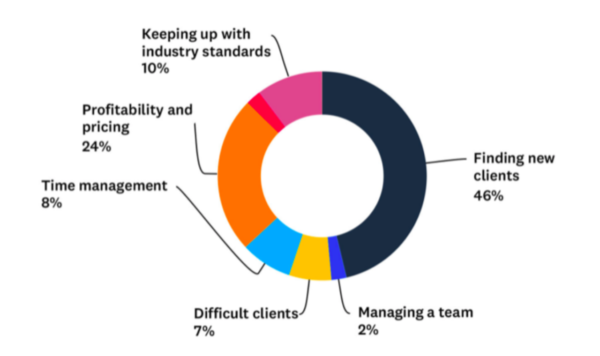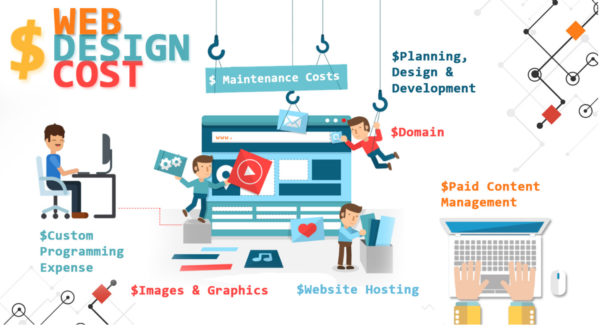
Whether you’re an experienced designer or just getting started, creating a website design questionnaire can deliver some impressive benefits. This easy-to-create tool leads your web design customers through the decision-making process.
A well-crafted website questionnaire will give you insight into what your clients expect from you and their new site. You’ll also learn more about their design preferences, budget, and other considerations that can help you develop a home on the web that meets their vision.
Tools and advice to help you find clients for your web development, IT, or computer systems design business.
Benefits of web design questionnaires
The main reason to create a web design questionnaire is to establish a conversation with a client about what they expect from you and what they hope to accomplish with their site. The process is beneficial for several other reasons:
- You’ll have a record of client preferences to refer to if you run into problems later.
- You won’t have to go back to the client to clarify details.
- It allows your client to think about the design in a deliberate, focused way.
- The survey can help clients arrive at difficult design decisions.
- Your clients will feel reassured that you are listening to them and that you value their business.
Providing a website design questionnaire to your clients can help you reduce many of the pain points web designers experience, as shown in a recent survey:

As you create your website design survey, keep your overall goal in mind. Are you hoping to help an indecisive customer narrow their choices? Or are you working with a customer set on a specific design?
Consider creating a few versions of your survey to ensure you capture the most helpful information for a given situation.
Examples of questions to ask when designing a website
Your questionnaire should include a mix of open and closed-ended questions. You may also want to include a preference scale option for some questions to gain a sense of what you should prioritize.
It’s important to keep your website design questionnaire organized and clearly worded. You should also keep the length manageable — ideally, no longer than is necessary.
These questions, arranged by category, will give you a good start for building your questionnaire:
Technical details
These questions help determine what kind of behind-the-scenes work you’ll need to do to get the new website online. You may need to gain access to the client’s existing domain server, for example.
- What is your ideal domain name?
- Do you want to improve an existing website or create a brand new one?
- What is the URL of your existing site (if any)?
- Who is hosting your site?
- Have you purchased a domain name or signed up for a hosting plan?
Goals
This category focuses on what your client wants to achieve by launching a website.
- What do you hope your website will help you accomplish?
- Do you plan to use your site for lead generation?
- Do you want your site to serve as a resource for existing clients?
- In regards to search engine optimization, do you have a list of target keywords?
Website elements and content
These questions focus on the functionality of the website and help you determine the complexity of the project. An e-commerce site with a large product catalog is a much bigger undertaking than a basic, informational website.
- Will you sell products or services on your website? If so, describe what you’ll be selling.
- Do you have existing web page content, or will we be creating all the content from scratch?
- What pages would you like to include (homepage, about page, and so on)?
Client communication
Ask your client for information that will help you effectively communicate throughout the design process. Some clients prefer phone calls, text messages, or emails. This is a chance to showcase your flexibility.
If your client knows they are always out of reach at certain times, it will help to make note of that early in the process. This can reduce the possibility of playing phone tag, which can throw off your expected timeframe and lead to frustration on both sides.
- What is the best way to reach you?
- Are there times we shouldn’t try to contact you?
- List some alternative ways to stay in touch throughout the project.
Product or service details
These questions give your customer space to explain their business in more detail. It’s important to have a clear understanding of what the business does on a day-to-day basis.
- What does your company do?
- Who are your target customers or clients?
- What is your motto and/or mission?
- Do you have a logo?
Design
These questions give you more information about how your client expects the site to look and feel.
- How would you describe the overall aesthetic you’re hoping to see?
- What three words come to mind when you think about how you’d describe your ideal website?
- Tell me about a few similar websites you like and why.
- Does your company use specific design elements across all your marketing channels? If so, do you have a style guide we can follow?
Competitors
Learning about your client’s competitors can help determine how to create a more effective, appealing website for your client.
- Tell me about a few websites your competitors are using. What do you like or dislike about them?
- What makes your brand stand out from your competition?
- What do you think your competitors are getting right?
Budget and finances
Many web designers dread discussing the financial aspect of their projects. Your website questionnaire can reduce awkward conversations later.
In this section, you could list your hourly rate or give a ballpark per-project price for different types of sites. This will give your client some insight into what a reasonable budget will look like. Some designers prefer to have the client propose a number and work from there.
- What is your budget for this project?
- How would you like to pay for the project? I can accept credit cards, PayPal, and payments by check.
When you’re working out an expected budget, try to account for direct and indirect costs.

Timeframe expectations
This category is key to your entire project. If the client has unrealistic expectations from the start, you’ll be having uncomfortable conversations throughout the process. You have an opportunity here to give the client a sense of how long it typically takes you to create different types of websites.
- When would you like to launch your website?
- When do you expect to see a mockup of the homepage?
- Do you have room in your timeline to account for edits, additions, and significant design changes after the project begins?
Post-design questions
Ask your clients questions that can help you secure ongoing business after the website launches. Many business owners may not have considered the work that needs to be done to keep their website current.
- Will you need help updating and maintaining your site after it launches?
- Do you need help developing blogs or content marketing?
Next steps
Before you send your survey to clients, be sure to take it yourself, as though you were a web design client. You’re sure to notice areas that could use a little fine-tuning. It’s a good idea to get some feedback from a colleague or friend as well.
Remember, your main goal for creating a website design questionnaire is to start a productive conversation about the client’s new site. The survey answers can provide valuable insight, but be sure to follow up with a discussion to clarify details and make sure you are on the same page.
Your website design questionnaire is not only a helpful planning tool, but it can also be an element of your marketing plan and help to grow your brand. Check out our technology services marketing guide for tips about building your website design business.




